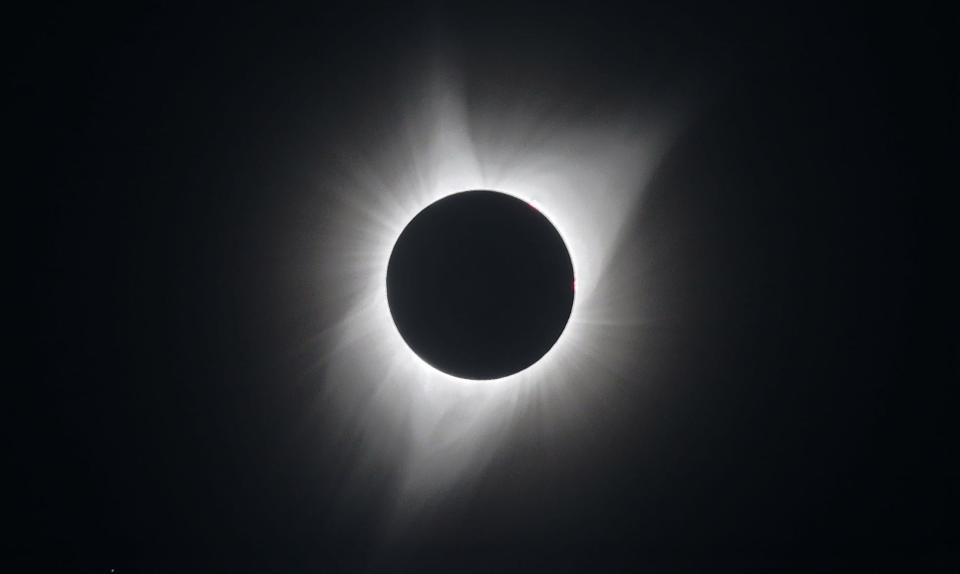'A cosmic masterpiece:' Why spectacular sights of eclipses never fail to dazzle the public
It's not often that solar eclipses race across our skies, the moon blotting out the sun to usher in either a wave of darkness or captivating rings of fire such as what will occur Saturday.
Years and years pass between these spectacular celestial events, that last of which occurred in 2017 when a total eclipse transformed the afternoon American skies seemingly into dusk. It's been even longer since we've seen an annular solar eclipse such as the one that will on Saturday travel in the U.S. from the coast of Oregon to the Texas Gulf Coast.
The phenomenon is not only rare, but undeniably beautiful.
That's why astronomers say it's no surprise that the promise of catching a glimpse of such a dazzling spectacle — whether it be a complete eclipse or only a partial one — always manages to fascinate us.
"I think humans have a deep connection with the night sky," Cameron Hummels, director of astrophysics outreach at the California Institute of Technology, told USA TODAY. "Astronomical events like eclipses, meteor showers, and the northern lights are a way in which they can experience it first hand."

Need solar eclipse glasses? Where to find them and why you need them
Partial eclipse is chance for millions to see 'ring of fire'
Millions of Americans have now long been eagerly awaiting what will be their only chance until 2039 to catch a glimpse of the so-called "ring of fire" emanating around the moon as it partially eclipses the sun.
Americans across the county will flock this weekend to eclipse watch parties at libraries, national parks and other venues to catch a glimpse of the phenomenon. That even includes places without a view of the the annular eclipse itself, which occurs when the moon passes in front of the sun at the farthest point of its orbit from Earth.
Because the moon appears too small to completely block the sun, it instead appears as a small disc in front of the larger, brighter star, which causes a halo effect that resembles the ring of fire.
It's a process scientists have long understood, but it hasn't diminished the excitement that bubbles up anytime an eclipse approaches. Many astronomers like Christopher Sirola from the University of Southern Mississippi even view eclipses as an opportunity to harness public captivation to educate about the science behind the phenomenon.
"Solar eclipses are very predictable, but their regularities are not obvious," Sirola said. "Such events are awesome, especially total solar eclipses."
Roadtripping and stargazing: Top 15 roadtrips in the US and solar eclipse activities at National Parks
Eclipses offer scientists a chance to study sun
We may think of astronomers and astrophysicists as studious and objective observers of the skies, but solar eclipses are equally exciting for them.
And while much of that eager anticipation is purely for the celestial light show that will be on display, there's an academic reason as well.
Describing eclipses as "a cosmic masterpiece," Elsayed Talaat of the National Oceanic and Atmospheric Administration told USA TODAY that the celestial events afford scientists an opportunity to study the sun much closer than normal.
Taking photos of the eclipse: Here's what to know about viewing and capturing the solar eclipse with your cellphone camera
Total solar eclipses in particular, such as the one that will overtake a large swath of the country in April, allow for scientists to test and improve human understanding of the laws of physics, primarily those of the sun. Veiled by the massive star's bright light, the sun's outermost layer known as the corona becomes visible during a total eclipse, allowing astronomers to conduct observations normally impossible, said Talaat, director of NOAA's Office of Space Weather Observations.
The corona to this day remains shrouded in mystery, as Talaat said scientists are unsure of just why the outermost layer is able to reach a temperature of 1.8 million degrees Fahrenheit compared to the 10,000 degrees measured on the surface of the sun itself.
Scientists at NOAA use a telescopic device called a coronagraph to replicate the effects of an eclipse by blocking out the direct light from the sun in order to measure a corona year-round without relying on the moon's orbit.
NOAA’s newest geostationary satellite will carry a coronagraph onboard when it launches for deep space next year, while a 2025 mission will also bring another device roughly 1 million miles away from earth to allow for unobstructed observations of the corona.
However, Talaat admits there's nothing like seeing an eclipse for yourself.
"It's very different to be able to see it with your own eyes from the ground; that's a very powerful experience for me," Talaat said. "It reminds me — it reminds us — that the sun is powerful in ways we don't fully understand or quite appreciate."
Eric Lagatta covers breaking and trending news for USA TODAY. Reach him at elagatta@gannett.com
This article originally appeared on USA TODAY: Solar eclipses never fail to dazzle us. Astronomers aren't surprised

